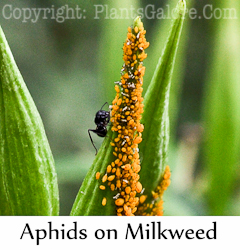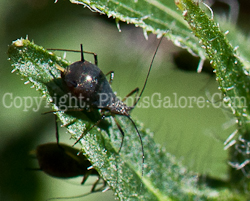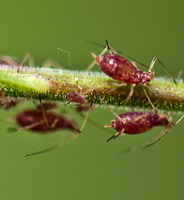|
 |
|
 |
|
 |
 |
 Aphids are small (less than 1/4 inch), soft
bodied insects that have sucking mouth parts. For
some reason, they have traditionally been called
"plant lice" even though they are no relation. Aphids are small (less than 1/4 inch), soft
bodied insects that have sucking mouth parts. For
some reason, they have traditionally been called
"plant lice" even though they are no relation.
Some types of aphids
feed on one species of plants only while others may
feed on several different plant species. They have a
somewhat complicated life cycles that may include
females who can produce eggs without being
fertilized by a male. Several generations of only
females can be produced over one summer.
Wooly aphids cover
themselves with a waxy substance that make them look
like a small cotton ball.
|
 |
|
 |
 |
 As with most sucking
insects the key symptoms include the yellowing of
the foliage due to the extraction of the green
molecule of
chlorophyll. In the process of digesting
the sap from a plant, aphids excrete a sticky
substance called
honeydew that falls on leaves
below. This causes the leaves to take on a shiny
appearance and may lead to the growth of a black, smokey colored fungus called sooty mold. As with most sucking
insects the key symptoms include the yellowing of
the foliage due to the extraction of the green
molecule of
chlorophyll. In the process of digesting
the sap from a plant, aphids excrete a sticky
substance called
honeydew that falls on leaves
below. This causes the leaves to take on a shiny
appearance and may lead to the growth of a black, smokey colored fungus called sooty mold.
The best sign of an aphid infestation is the actual
presence of the insect itself. Although small,
aphids are easily seen with the unaided eye. They do
move around but, while they are eating, they have
their snout stuck into the plant tissue. Aphids will
be found feeding on the bottom of leaves and on
tender new plant shoots.
|
 |
 |
 |
Aphids are generally
not very destructive. If in large numbers, they may
stress the plants by withdrawing the sap. So the
best prevention is probably just to keep an eye on
plants in your landscape that are usual hosts to
them.
|
 |
 |
 |

Fortunately, once they
are discovered in large numbers on a plant, aphids are
easy to control. Many commercial
insecticides are
labeled for this insect. Many other options would
include the use of insecticidal soaps and other organic
treatments.
|
|
 |
|
Note: We
have provided some general information and
observations on this topic aimed at the home
gardener. Before you take
any serious action in your landscape, check
with your state's land grant university's
Cooperative
Extension
Service for the most current,
appropriate, localized recommendations. |
|
 |



